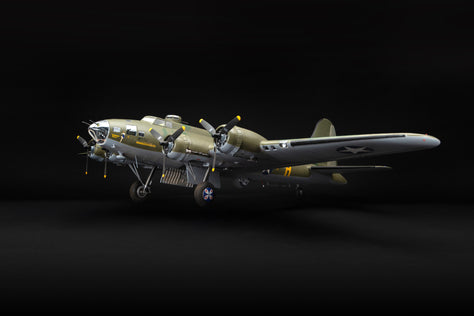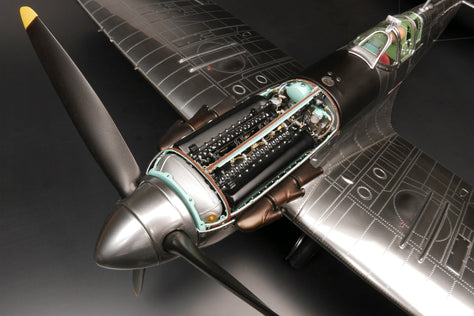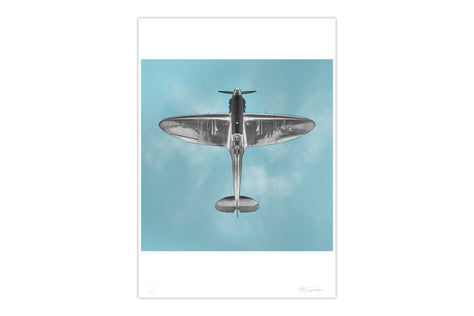Technical Details
- Description
- Scale guide
Only six of the edition of ten Aircraft Replicas remain.
The fastest fighter-bomber of World War II, the hugely versatile and high performance de Havilland DH98 Mosquito was unquestionably the greatest contribution made by the de Havilland Aircraft Company to the success of the Royal Air Force in the Second World War. Its innovative design made use of a wooden 'sandwich' construction, drawing upon the experience gained from the company's pre-war high-speed DH88 Comet Racer, and the streamlined DH91 Albatross airliner. Such was its popularity with pilots that it soon became affectionately known as ‘The Wooden Wonder’. Originally conceived as a high-flying, unarmed photo-reconnaissance aircraft, the Mosquito saw service in wide-ranging roles from bomber, fighter-bomber, night-fighter, anti-shipping strike, trainer, torpedo bomber and even as a target tug.
By 1938, the Air Ministry had started looking for a heavily-armed, multi-role aircraft, but showed very little interest in de Havilland’s concept, instead ordering them to build wings for other bombers as a subcontractor. From the 4th of September 1939, Britain was at war with Germany and British aircraft production was extremely concentrated on fighters such as the Vickers Supermarine Spitfire and the Hawker Hurricane, with new facilities being created to meet this demand as well as heavy bombers like the Vickers Wellington and Armstrong-Whitworth Whitley. As the conflict progressed, raw materials were in short supply and so the use of alternative non-strategic construction resources became increasingly important. Additionally, greater significance was also placed on the requirement for new aircraft designs to have a multi-role capability. Despite initial designs receiving an unfavourable reception, de Havilland persevered. Eventually and after a number of further impressive submissions, the Air Ministry warmed to the concept of the Mosquito and a draft requirement was raised for a high-speed, light reconnaissance bomber capable of over 400 mph. To maintain secrecy, the project was designed 6½ miles south of Hatfield at Salisbury Hall, and was initially financed as a private venture, only finally receiving official backing with the eventual release of Specification B.1/40 in March 1940, which called for 50 bomber/reconnaissance variants. This was supplemented in May by Specification F.21/40, calling for a fully-armed, long range fighter, authorising de Havilland to build a fighter version of the Mosquito.
Initial construction of the three prototypes was very slow due to severe shortages of basic materials, and the project was almost cancelled after heavy losses at Dunkirk, Air Vice-Marshal Freeman rather conveniently ignored the instructions issued by Lord Beaverbrook, Minister of Aircraft Production. The first prototype DH98 Mosquito (W4050 - E0234), painted in 'prototype yellow', first flew at Hatfield on the 25th of November 1940. The take-off and flight were considered relatively problem free, despite the undercarriage doors remaining slightly stuck open. Various handling and performance issues were ironed out over the next couple of months and, during trials on 16th January 1941, the prototype outpaced a Vickers Supermarine Spitfire. A second DH98 Mosquito prototype (W4051) first flew as a photo-reconnaissance variant on 10th June 1941, while a third prototype (W4052) was used for the development of the fighter variant with cannon and machine gun armament. It would also carry Airborne Interception (AI) equipment to enhance both its night and day fighter capabilities.
The Mosquito entered service in 1942 and was an immediate success becoming well-known for its bombing, pathfinder and precision, low-level strike capabilities. Wartime development resulted in a wide range of variants, including the navalised torpedo-reconnaissance Sea Mosquito TR Mk.33 that saw service in the Far East, and a significant increase in bomb load capability and range after the incorporation of a larger bomb bay and auxiliary fuel tanks. The Mosquito saw glory on a number of operations, the most famous being Operation Jericho on 18th February 1944. On another occasion, a precisely timed daylight attack on the main Berlin Broadcasting Station interrupted an arranged speech by German Commander-in-Chief Herman Göring to celebrate the 10th anniversary of the Nazis’ seizing power, prompting a huge propaganda victory. Mosquitos flew their last wartime mission in the European theatre on 21st May 1945 when aircraft of RAF Coastal Command joined the hunt for German submarines that may have been tempted to disobey the surrender order.
In total, 7,781 DH98 Mosquito aircraft were built. The Mosquito primarily saw service with the Allied air forces during the Second World War, including both the United States and Russia alongside the RAF. Civilian versions were also developed and used as transport aircraft, often flying across the North Sea to neutral Sweden. Postwar, many were operated by the air forces of France, Belgium, Turkey, Sweden, Dominica, South Africa, Yugoslavia, Australia, Canada, China, Czechoslovakia, Israel, New Zealand and Norway. The final operational flight by a Mosquito was in May 1963, when No.3 Civilian Anti-Aircraft Co-operation Unit retired its TT.35s.
This fine handcrafted 1:16 scale replica of the DH.98 Mosquito represents FB.VI HX922 as it was piloted by Group Captain Percy Pickard and navigator Flight Lieutenant John Broadley at the commencement of Operation Jericho on the 18th of February 1944. Operation Jericho was the name given to the precision bombing raid on Amiens prison, a mission designed to disrupt the Gestapo’s plans for the French Resistance prisoners held there. Nine Mosquito FB.VI bombers, operating out of RAF Hunsdon in Hertfordshire, attacked the German-held prison at Amiens on the edge of the Somme Valley. Their skilful airmanship delivered low-level waves of bombs, first destroying the outer and inner prison walls, quickly followed by the guard house. A total of 255 allied prisoners escaped through the breaches in the buildings and walls, although sadly 182 were soon recaptured. As HX922 flew away from the target, their aircraft was set upon by the Focke-Wulf Fw 190 of Feldwebel Wilhelm Mayer whose first burst of fire severed the Mosquito's tail section. The aircraft flicked onto its back and dived into the ground, exploding in flames on impact at St Gratien, 8 mi (13 km) north of Amiens, killing Group Captain Percy Pickard and navigator Flight Lieutenant John Broadley. Pickard was posthumously awarded the Distinguished Service Order and two Distinguished Flying Crosses from an illustrious career, Broadley the Distinguished Service Order, the Distinguished Flying Cross, and the Distinguished Flying Medal.
Please note that, due to the large size of this piece and complexities of shipping, additional costs will be calculated and billed separately based on delivery location.
This model is one of a strictly limited edition of 10 models at 1:16 scale.
Pre-order
Bespoke
In order for us to create your bespoke model, you will need to choose 4 extra options. Paint colour, interior colour, wheel style and caliper colour.
Please complete the form and a member of our Sales Team will contact you.
Contact Us
Please contact us for more information about ordering this model.


![[hide-in-gallery]](http://www.amalgamcollection.com/cdn/shop/files/Heroimage-webedit_262b9317-d67c-4b87-b538-de86d706edd7_2000x850_crop_center.jpg?v=1718181764)



